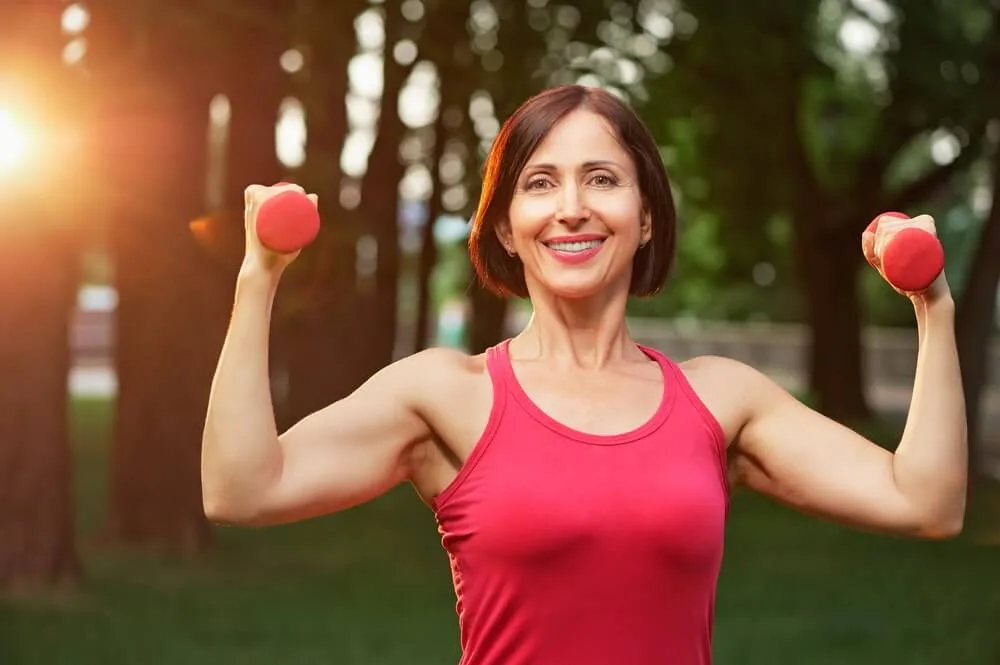We’re often asked whether Pilates counts as resistance training. You probably don’t think of Pilates as resistance training as for a long time, Pilates was probably more well-known as an exercise performed lying down in a class on mats and perhaps didn’t appear to use a great deal of exertion.
However, Pilates can be considered strength training but not in the same way as traditional weightlifting or resistance training.
Quick Summary: Is Pilates strength training?
1. Pilates Can Be Resistance Training When It Includes Added Load
Pilates exercises that involve springs, resistance bands, weights, or bodyweight movements (like planks or push-ups) qualify as resistance training. These elements challenge the muscles similarly to gym-based strength exercises and can be adjusted to suit different fitness levels.
2. Pilates Can Build Strength — If It Follows Strength Principles
To be effective for strength training, Pilates must apply the principle of progressive overload — increasing resistance over time to fatigue the muscles. Without sufficient resistance, some Pilates movements may not provide enough challenge to improve muscle strength or build muscle mass.
3. Pilates Complements Traditional Strength Training
Even if not always maximally loaded, Pilates enhances strength through improved body control, posture, and movement efficiency. It’s particularly valuable for rehabilitation, beginners, or as a complement to gym-based workouts, offering strength benefits with added focus on form and alignment.
What is Pilates?
You may wonder what sort of exercise Pilates is, as it may not be immediately obvious. Many people think that Pilates is about stretching and may not know the difference between Pilates and Yoga.
You probably don’t think of Pilates as resistance training as for a long time, Pilates was probably more well known as an exercise performed lying down in a class on mats and perhaps didn’t appear to use a great deal of exertion.
The creator of Pilates – Joseph Pilates – actually designed lots of exercise equipment based on his extensive project of rehabilitating himself from childhood during the early 20th Century. This equipment is very similar to the equipment that you see today in Pilates studios. Mat based exercises were a small part of the system of exercise that Joseph Pilates used.
The Pilates exercises are a system of exercises exercising different parts of the body. The main principles are: alignment, centring, breathing, concentration, relaxation, coordination, balance, flowing movements and stamina.
As Pilates has become more popular there has been an explosion of classes using one piece of equipment in particular – the Reformer. This has introduced a whole new wave of people to the concept of Pilates equipment. Both matwork and equipment Pilates offer a whole array of opportunities to work with resistance and we are going to explore them here in this article.
What is resistance exercise?
To know if Pilates is resistance training it is important to know what we mean by resistance exercise. Generally speaking, resistance exercise involves working your body against a resistive force which can be body weight, or it can be a weight or a resistance band. It can even be gravity. The Pilates equipment utilises springs which as you can see, is a method of resistance.
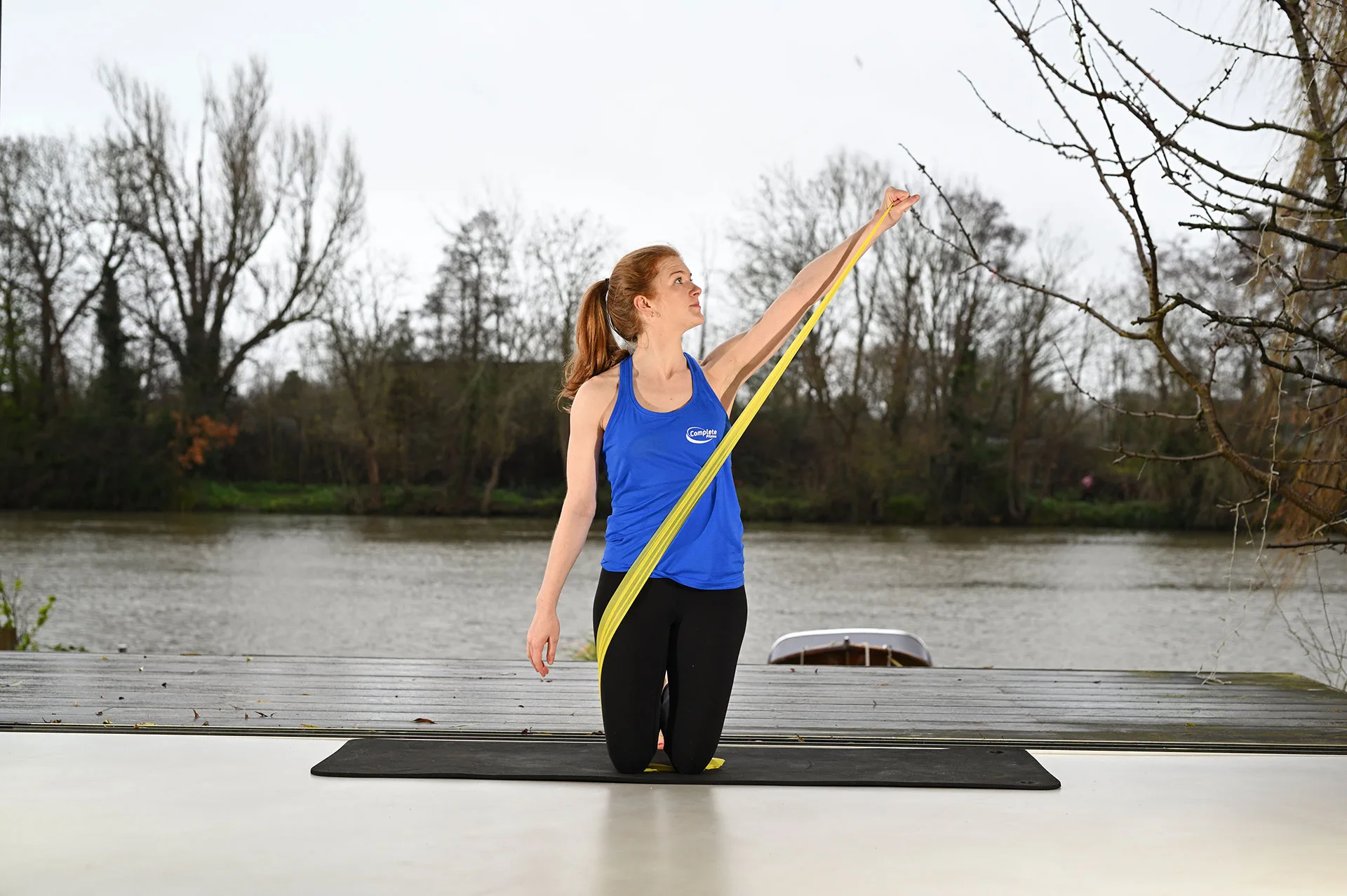
What is strength exercise?
Resistance exercise is not exactly the same as strength training.
Strength training involves using resistance but there is a specific goal of training the muscles to be able to produce more force and power. In order to produce more force, you need to work with what is called the principle of progressive overload. This requires working against more resistance than you do in everyday movements, and continuing to work with progressively greater load over time as you adapt to each new level.
How much resistance you need depends on whether you only want to get stronger, or whether you want to build muscle bulk or whether you want to build endurance in your muscles, so it’s helpful to consult with a professional when considering these aims.
When you aim to increase your strength, you should be doing enough repetitions that your muscles fatigue. A good guide is to work at a weight so that you feel the last 2 reps are really tough. For example, if you were to do press ups, you should continue doing the exercise and your last 2 repetitions are a struggle to physically push yourself up from the floor.

Is Pilates resistance training or strength training?
Some exercises in Pilates are definitely resistance training as they involve lifting your body weight, for example the Pilates mat exercise leg pull. Other exercises that involve lifting arms or legs or curling the spine won’t count as resistance because you are moving the limb without added weight and this is similar to everyday demands. However, if we add weights, a resistance band, or a spring, then we have changed that movement into a resistance exercise.
Related Reading: Pilates Resistance bands movements
If you are recovering from injury or illness or you are just not used to exercising, just the repetitive movement of moving your arms and legs might be enough to challenge you. If you are very fit and used to exercising then you may need a significant level of resistance added to your Pilates routine to make it challenging.
Does Pilates help build muscle?
Pilates can be used as strength training and can help to improve muscle strength but it is important to be working with enough resistance to tire the muscles and the amount needed varies a great deal from person to person. The specific goal of building muscle bulk requires repeating a resistance exercise in 3 – 5 sets of 8 – 12 repetitions, using sufficient resistance that you are struggling to complete repetitions by the end of each set.
5 Pilates resistance exercises to help build strength
1. Bridge with weight
- Start lying on your back with feet flat on the floor. Place a dumbbell of your choice across the top of your hips and hold with a hand on either side. Press your feet down as you lift your hips to the top of range. Lower hips down with control. Repeat 3 sets of 10 repetitions.
- Progressions: feet raised onto box/chair etc., add a theraband around your thighs and keep them pressed out in a parallel position.
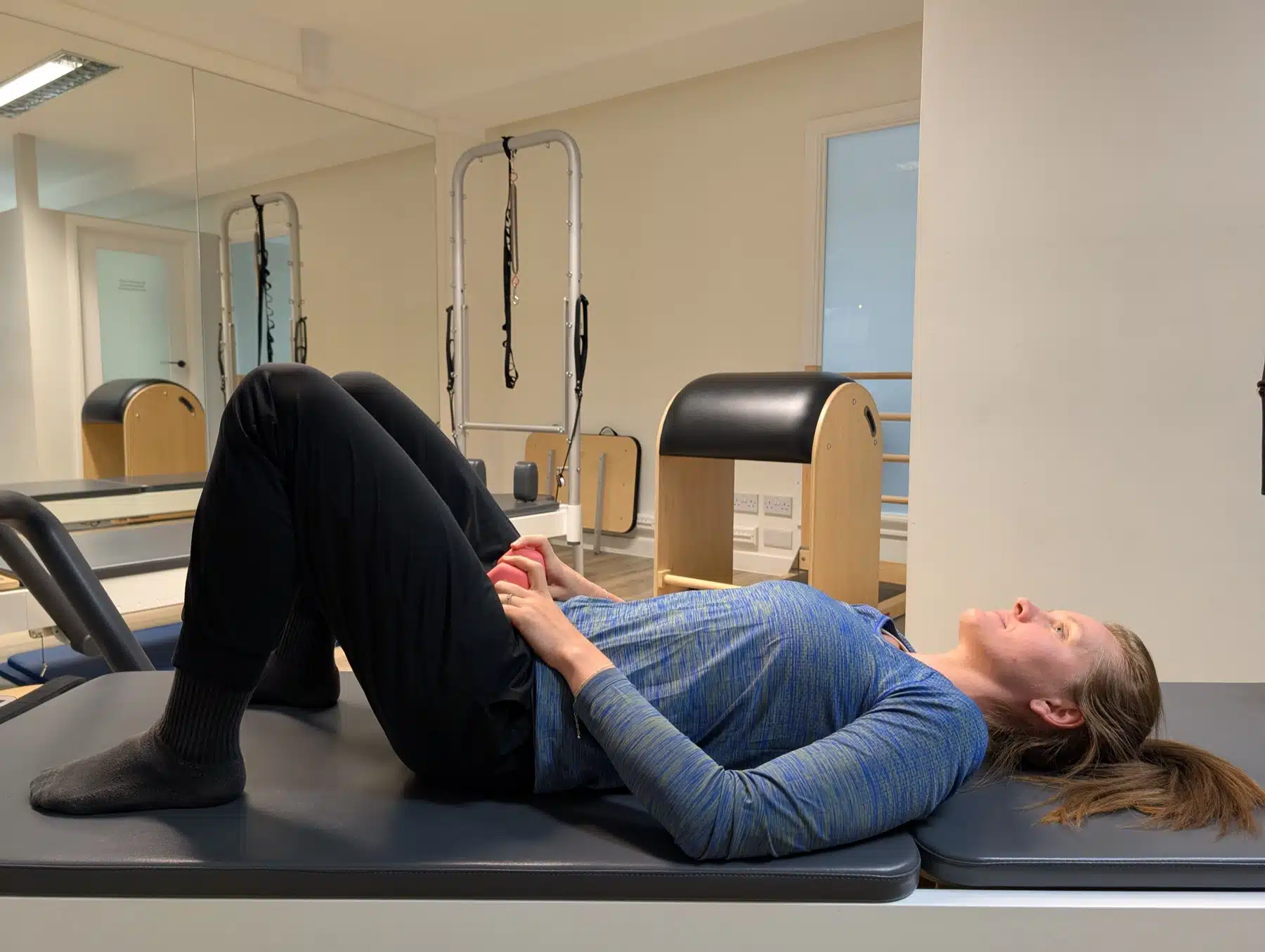
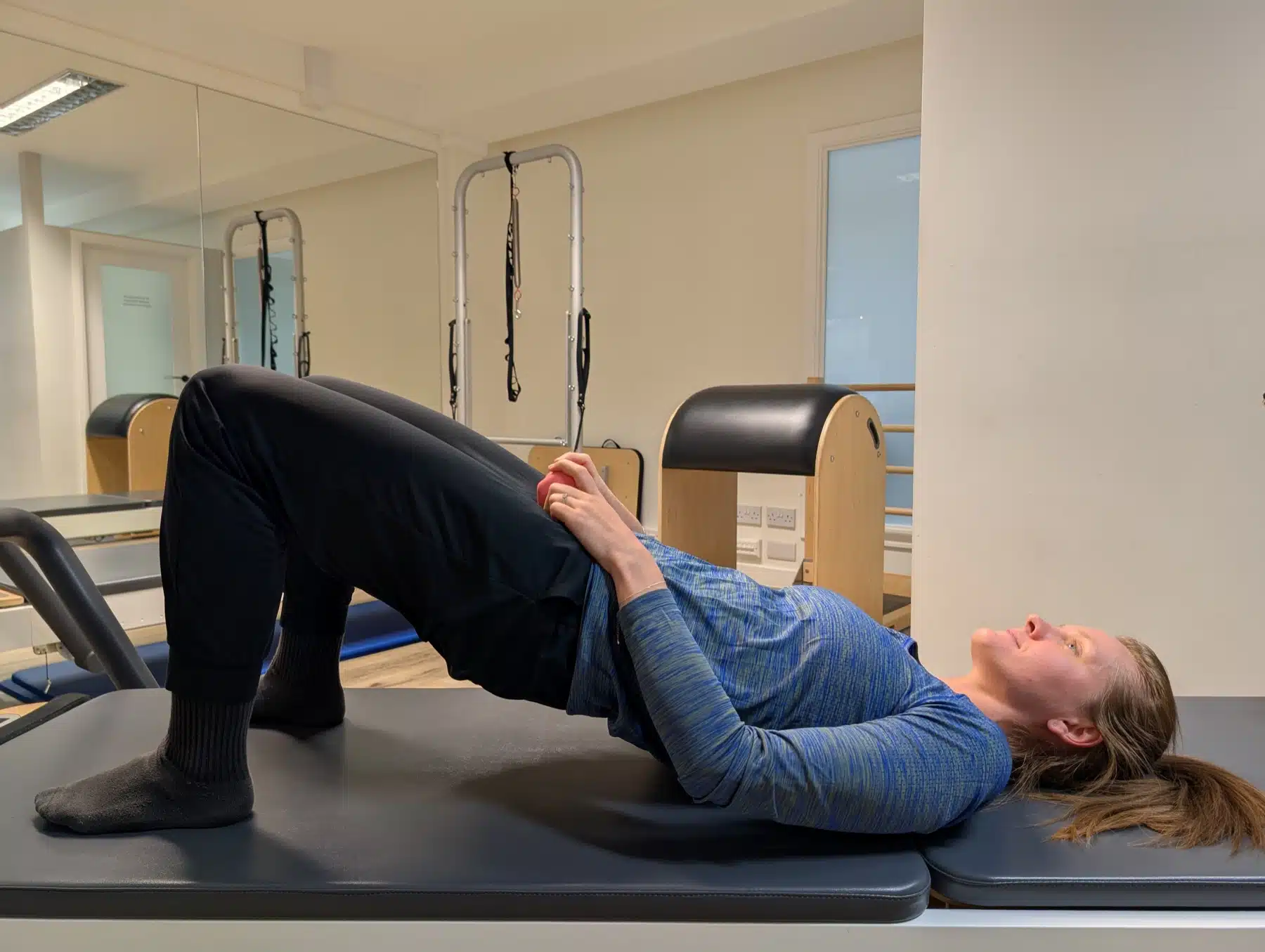

2. Split lunge hold with powerband row
- Attach a powerband to a pole or a stable attachment. Hold the theraband in one hand and walk back until there is tension on the band. On the side of the body that you are holding the band, step the leg back with weight on the toes. Lower the body straight down, holding a lunge position with the knee just off the floor. With your band arm, pull the elbow past your side, bringing your shoulder blade towards your spine, hold for 5 seconds, then slowly release the arm ahead. Repeat 3 sets on each side of 10 row repetitions.
- Regressions: if holding the lunge is too hard, start with the knee resting on a mat or, start in a double leg squat hold position.

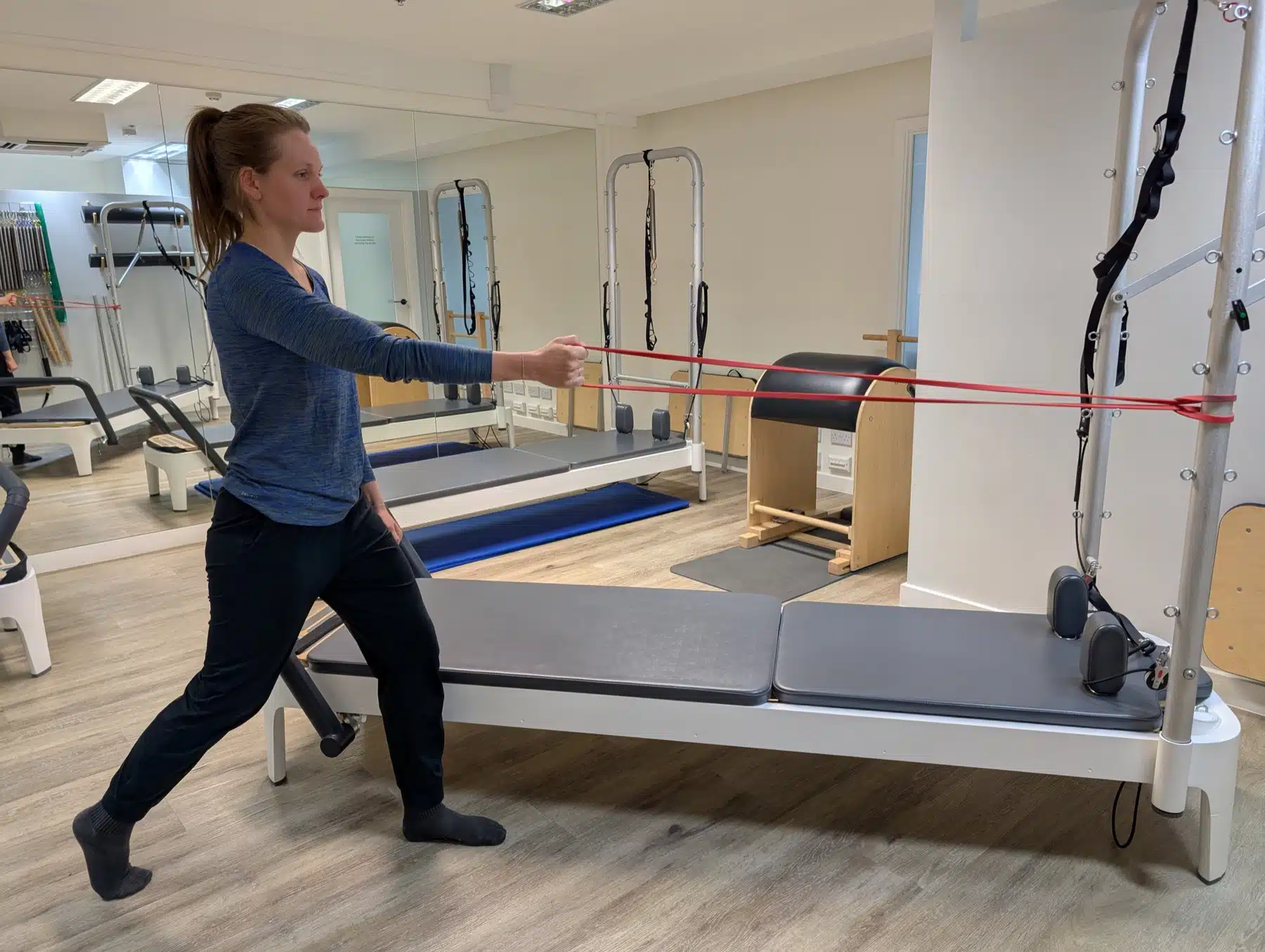
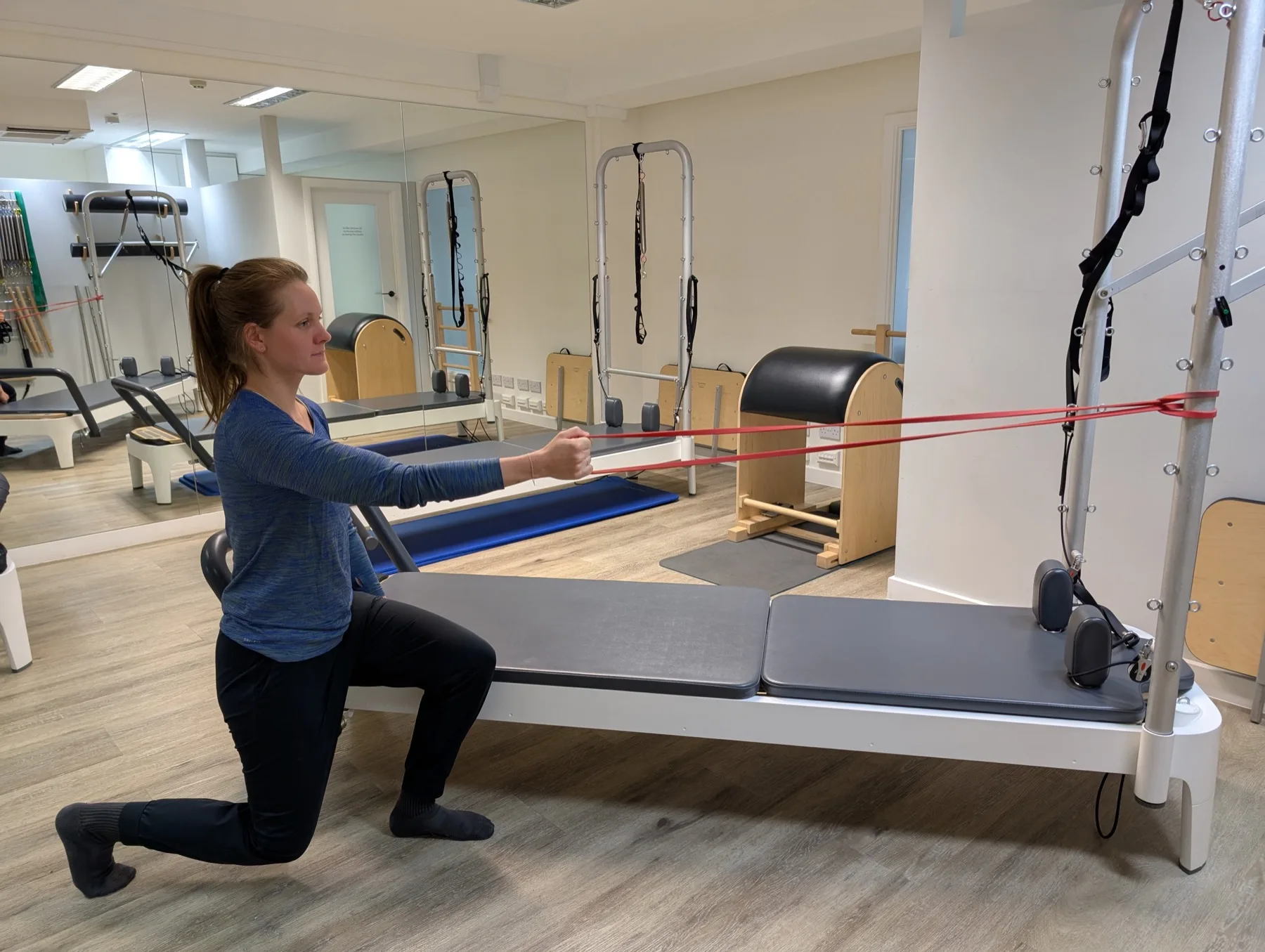

3. Kneeling side plank with clam
- Lying on your side, prop your elbow under your shoulder with your forearm and hand resting on the floor. Stack your legs and bend your knees. Push your arm down and lift your hips up into a kneeling side plank. Keeping your feet together, lift your top knee up and open without rotating your trunk and pelvis into a clam. Repeat 3 sets of 12 repetitions each side.
- Progressions: add a theraband around your thighs to add resistance.

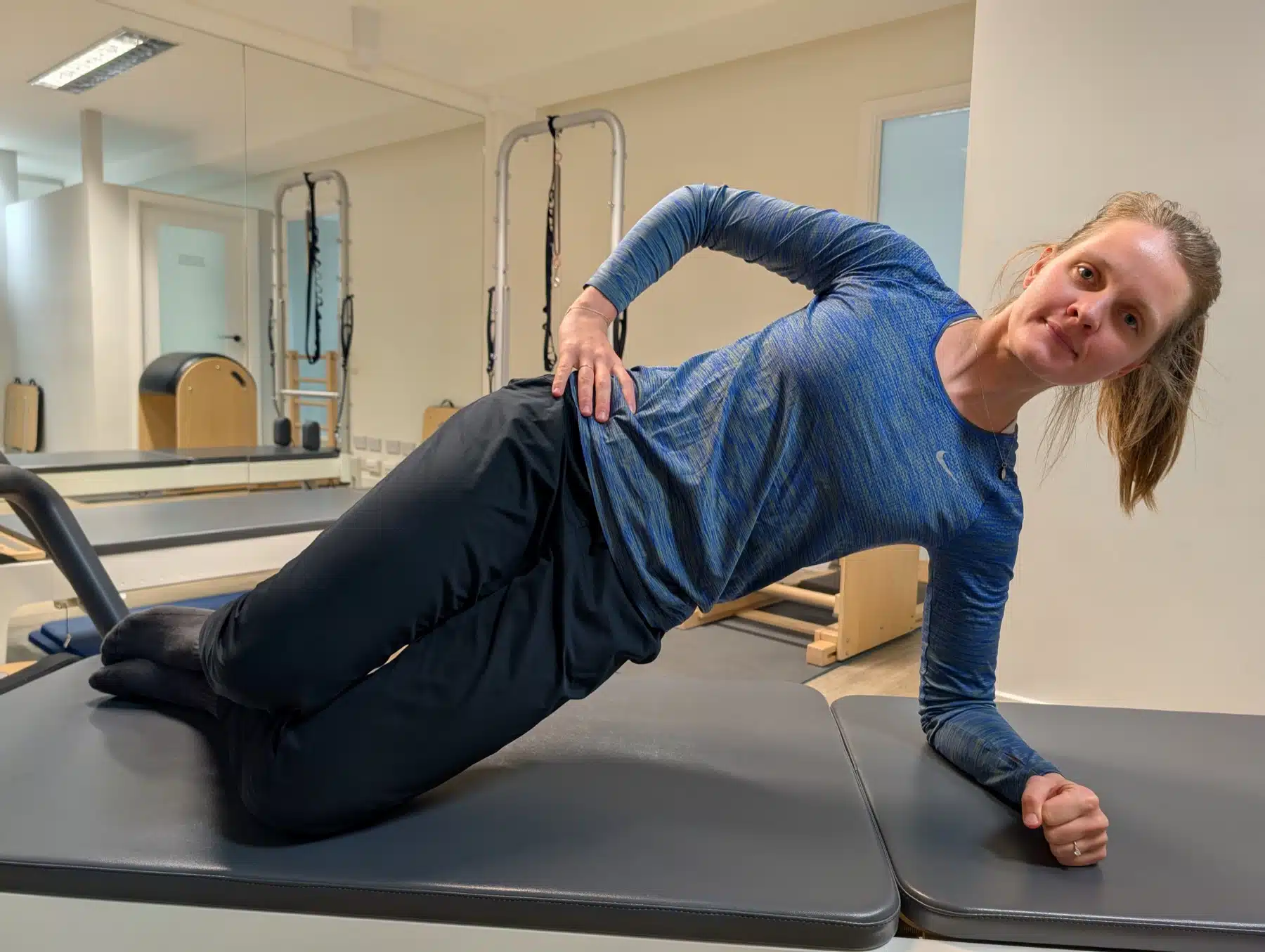
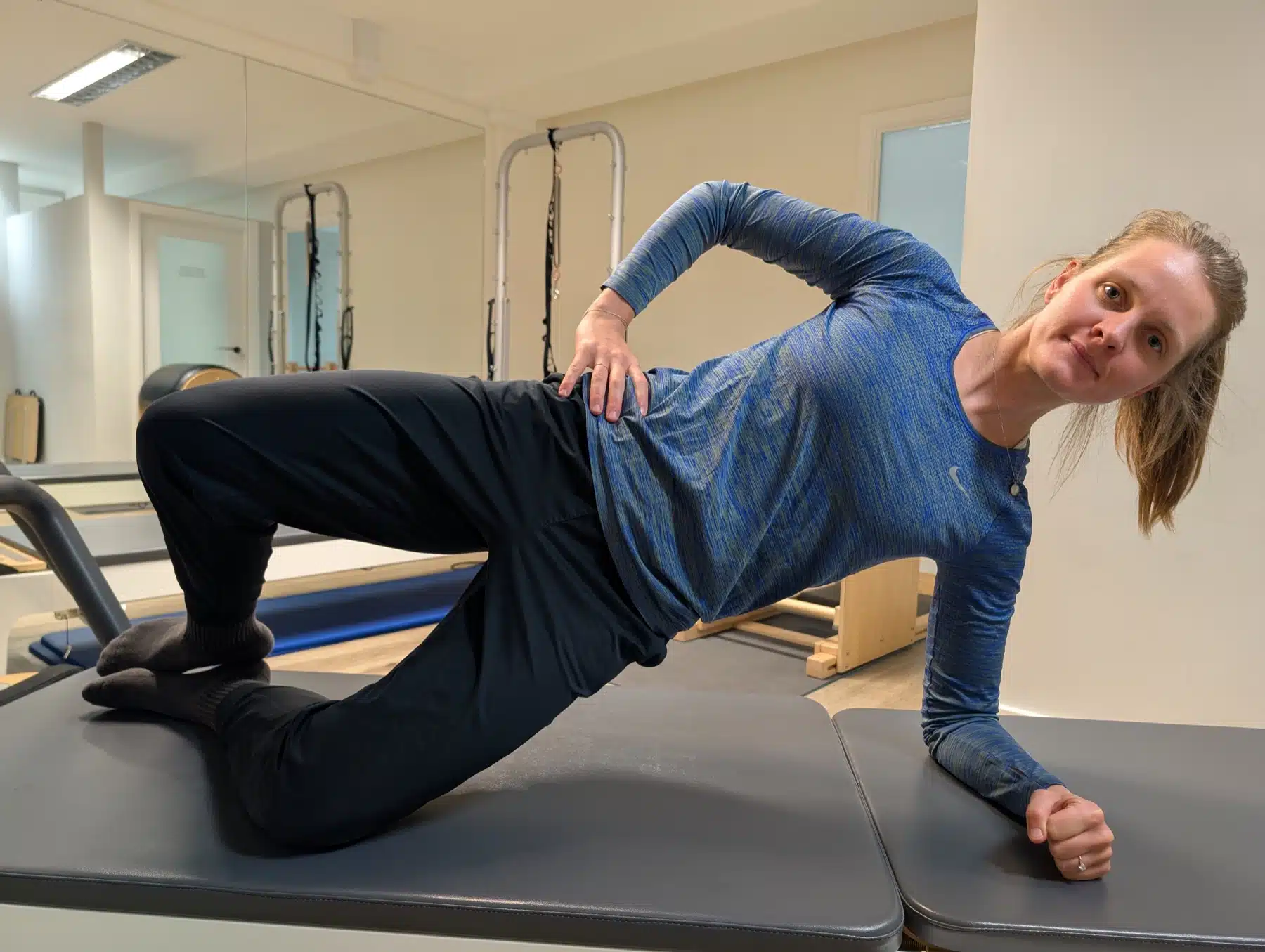
4. Leg press on Reformer
- Lying on your back on the reformer. Find your neutral spine. Place the heels of your feet on the bar. With a moderate-heavy resistance, press your feet into the bar, lengthening your legs with control. Slowly allow the knees to bend as you control the carriage of the reformer back in. Repeat 3 sets of 10-12 repetitions.
- Progressions: add more springs to increase the resistance or, place one leg into table top and try a single leg press.
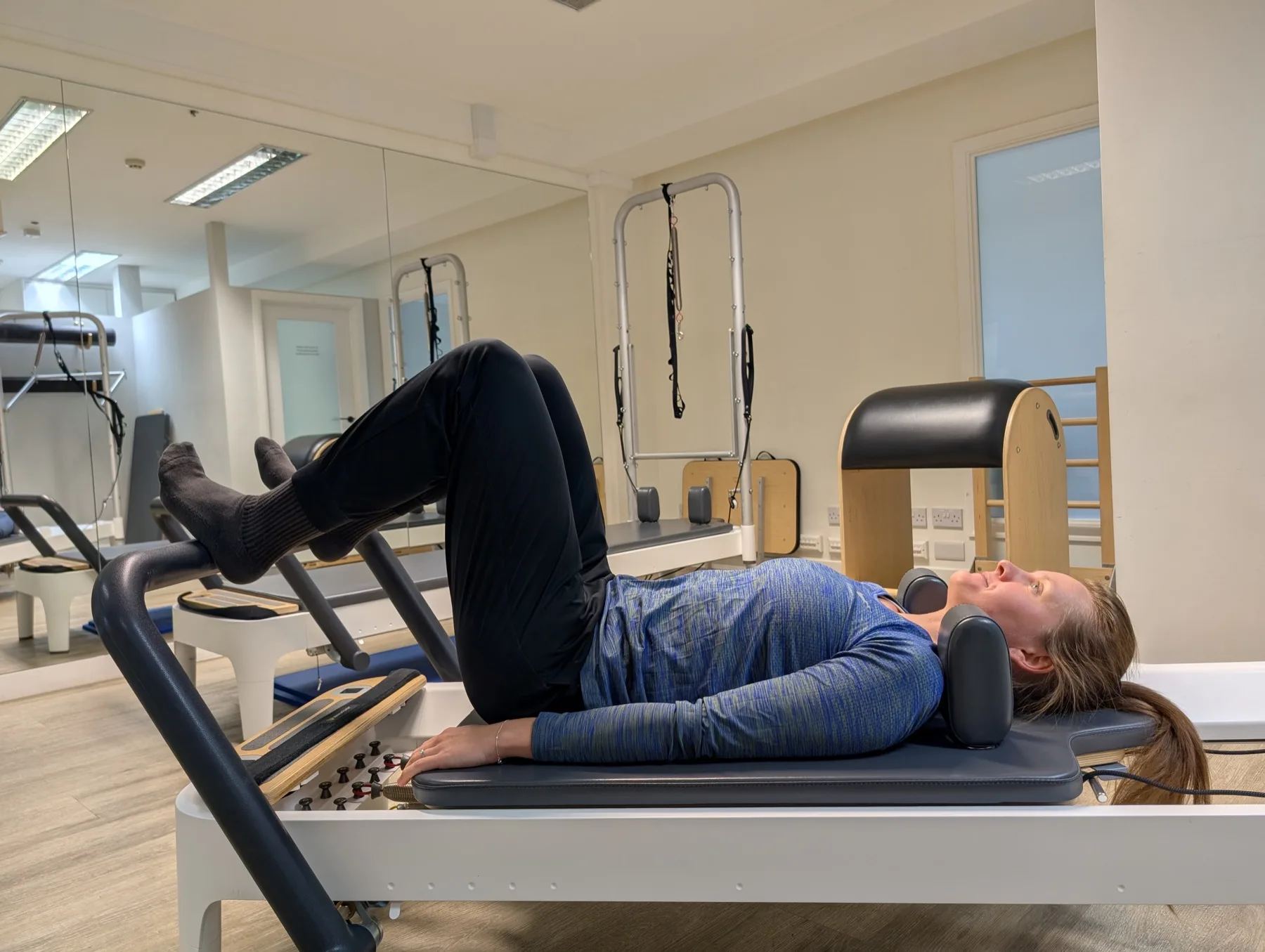
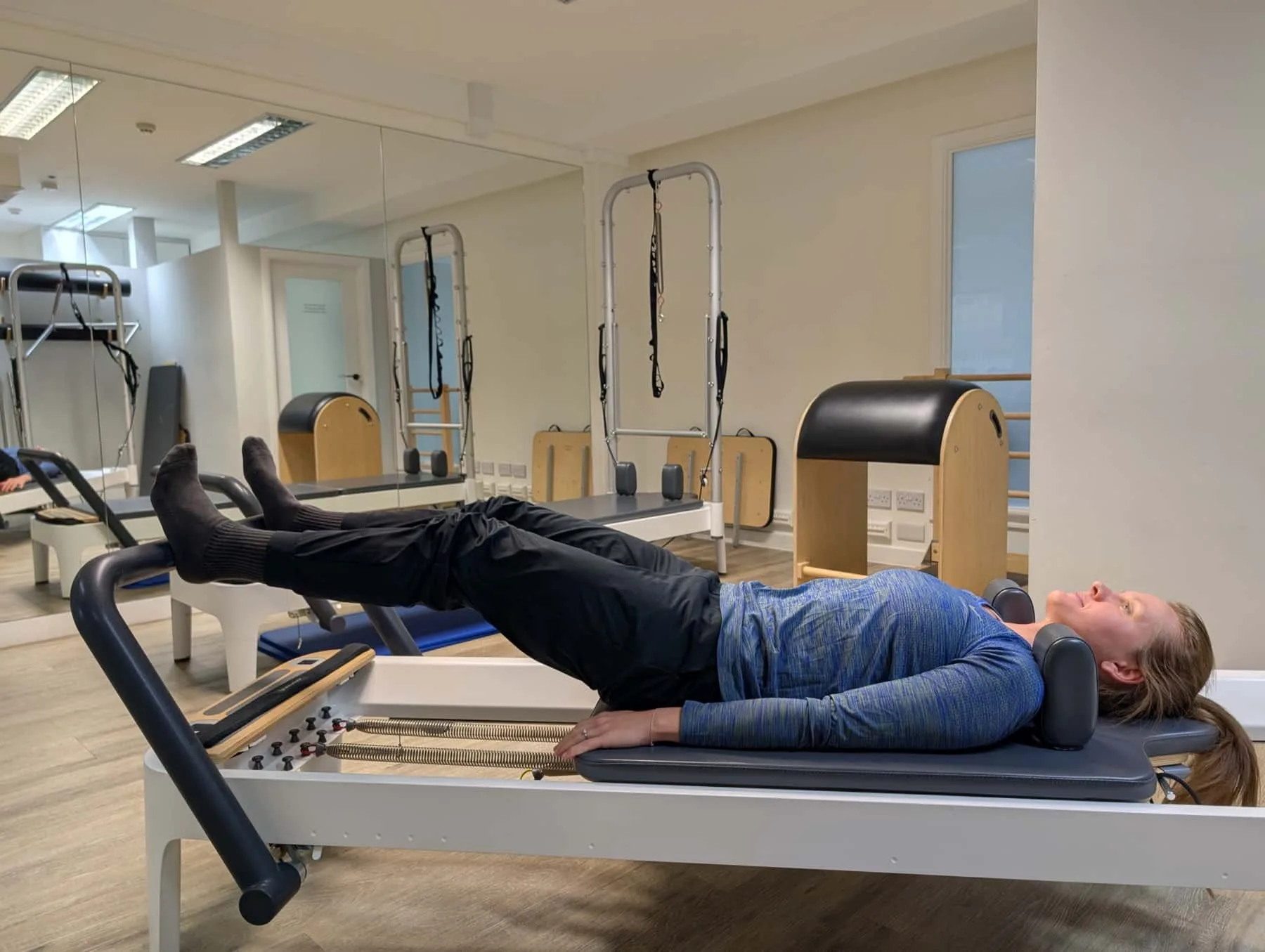
5. Long box pull up on Reformer
- Lay box length-ways on Reformer. Lie on your stomach with head towards the hand strap end, chest just over the edge. Lengthen your legs long and squeeze big toes together (if you experience back discomfort in this position, keep your knees bent and heels towards bottom). With a low-medium resistance, pull yourself ahead using the side rails to the front strap poles, wrapping your hands around the outside. Engage the muscles under and behind your armpits as you pull your elbows back behind your body and pull yourself ahead. Hold the position for 5 seconds and slowly release the arms ahead. Repeat 3 sets of 10 repetitions.
- Progression: increase the resistance of the springs


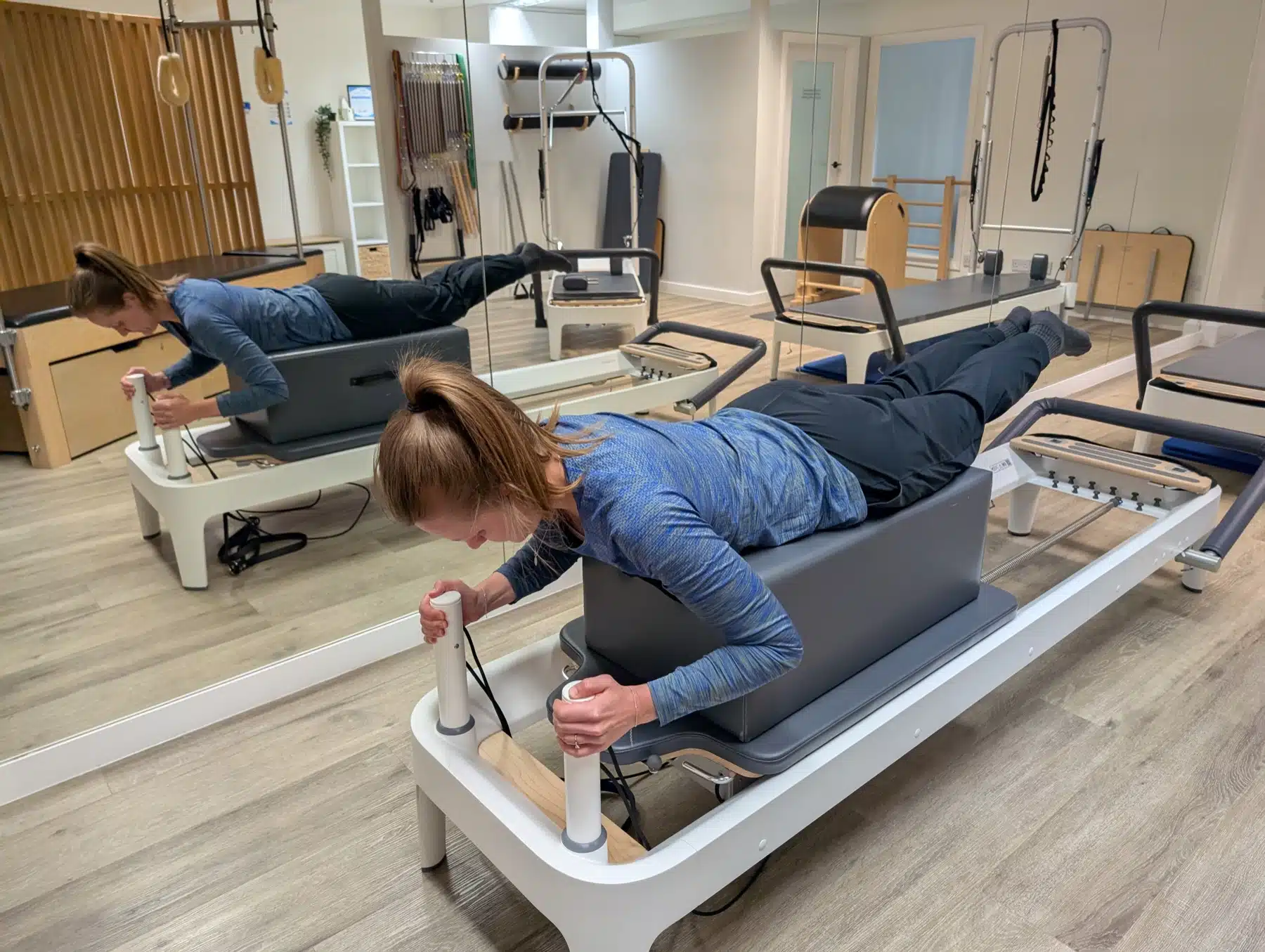
FAQs
Should you bother doing Pilates if you’re looking to build strength?
Yes! Even if you prefer to work on your strength training in the gym, Pilates has other benefits that can complement your strength training routine. In Pilates you focus a great deal on the form and quality of movement. A lot of the movements are movements that you use to execute strength training exercises. You use mirrors, and body awareness training to increase your understanding of efficient and effective movement. Quite often, an exercise that looks easy in Pilates can be really challenging when you are shown how to do it well.
If you are doing small classes or one-to-one sessions you get valuable feedback from instructors about the best way to move.You will also benefit from having exercises tailored to your abilities.
Finally, the myriad ways that you can exercise in Pilates, especially using the equipment can provide much needed novelty and fun in your exercise routine!
How often should I do strength training?
During a strength training session, the recommended format is to repeat a resistance exercise in 3 – 5 sets of repetitions. The number of repetitions depends on whether you want to work on strength, endurance or building muscle bulk.
If all this sounds like a lot, then don’t despair, there is some research that suggests that there are still gains to be made from one session a week and lower loads than previously advised.
The reality is that some strength training is better than none and should still benefit you. It is important to do an amount that you can stick to with consistency, and enjoy, over a long period of time.
How much strength training should I do?
It is generally accepted that during the first 6 – 8 weeks of a resistance training programme the improvements that you make are due to improved connection between your brain and your body.
To be able to change the actual muscles so that they become better able to generate force, you need to be training for a minimum of 3 months. To see significant improvement, you need to be in this for the long haul!
If you are strength training after a significant injury or surgery research shows that gains are being made for up to a year or sometimes two after the surgery.
Is Reformer pilates strength training?
The Reformer is such a versatile piece of equipment it can help train many aspects of movement including control and stability, coordination and balance and yes, strength! The Reformer uses springs to add resistance to exercise, and just like weights or gym machines, these can be added or reduced depending on the aim of the exercise and the person using it. In some instances, the springs alone will be enough for some people to challenge their muscles enough to build strength, for more advanced people, they may need to complement their Pilates training with other heavier weight-based exercises. As we’ve discussed above, it’s important if strength is your goal to get your reps and sets right as well as your load.
Can you do Pilates and weight lifting / training?
Pilates is a fantastic form of exercise to complement weight and strength training. To perform well in strength training, it is important to move with good mechanics, have good mobility and control of your joints through full range of movement and a good base of stability throughout the core and the body. Pilates helps to build all of those things, providing an ideal platform for your body to perform at its best. Furthermore, due to the low load nature of Pilates, it also works as a great form of active recovery, allowing your muscles and joints to recover between harder and more intense weight sessions.
Can I replace strength training with Pilates?
This will depend on what your goals are and what your current strength levels are. For some people, the resistance provided in Pilates is enough of a challenge to help improve their strength. For others, it may not be enough to load the muscles and induce a change in strength. If you’re unsure what’s right for you, discuss with your instructor and they can help guide you on what’s the most appropriate.
Our physiotherapist-led reformer Pilates studios in Chelsea, our Angel reformer Pilates studio and our reformer Pilates studio in the City, offer a highly tailored approach to your Pilates training, whether your goal is to manage a health condition, rehabilitate from an injury or to improve your strength and fitness.
Get in touch with us via email or contact us on 0203 764 5668 for further information.
Education is key:
These blogs are designed to give information to everyone, however, it is important to remember that everyone is different! If you have not seen one of our therapists and have any questions about injuries, what you have read or whether this may be useful to you, please just ask. We are more than happy to help anyone and point you in the right direction. Our biggest belief is that education is key. The more you understand about your injury, illness and movement, the more you are likely to improve.


